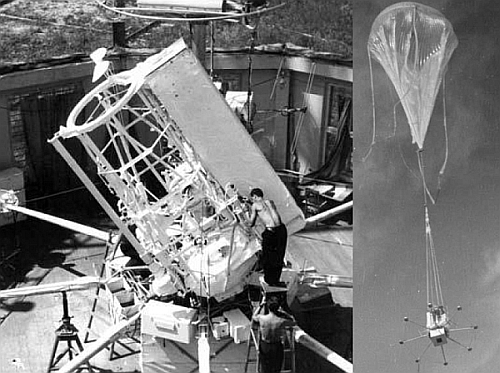Purpose of the flight and payload description
The Soviet Stratospheric Solar Observatory also known as SATURN was a balloon-borne telescope developed at the Pulkovo Astronomical Observatory and built at the Kazan Optical-Mechanical Plant in the Soviet Union in the 1960's decade. Designed as a comprehensive solar research station and equipped with multiple optical and electronic instruments capable of capturing high-resolution images and spectrographic data from the stratosphere, it represented a major advancement in high-altitude solar observations enabling unprecedented clarity in observations of solar granulation and spectral analysis.
The observatory which can be seen being prepared, and shortly after launched in the image at left (click to enlarge) was a large, complex assembly that integrated a telescope, a spectrograph, photographic cameras, a photoheliograph, and auxiliary electronic systems. The core of the observatory was its telescope, which followed a Cassegrain optical configuration. The initial version used a 50 cm primary mirror which was replaced by a 100 cm mirror in the fourth and last flight. The telescope had an effective focal length of 24 meters, which was extended to 120 meters with an enlarging camera. This long focal length was crucial for achieving high magnification and capturing fine details of solar structures.
Light from the telescope was split using a light-dividing optical system. The majority of the light was directed toward a spectrograph, while a smaller portion was sent to the enlarging camera. The spectrograph was a diffraction-based instrument with a 14 cm x 15 cm grating featuring 600 lines per millimeter. It was optimized for spectral analysis in the yellow-green region, focusing on specific solar features such as the H-alpha line, sodium D1 and D2 lines, and the H and K lines of ionized calcium (Ca II). The spectrograph had a dispersion of 0.80 Angstroms per millimeter in the fourth-order spectrum, allowing for precise measurements of solar absorption features. The photographs were recorded on high-resolution Soviet fine-grain film with exposures set at 0.1, 0.3, and 1.0 seconds. A separate auxiliary camera was dedicated to photographing the spectrograph slot, ensuring that the exact regions of the solar spectrum being analyzed were documented.
The enlarging camera, designed to enhance the resolution of solar images, produced an 8 cm-wide frame with a field of view of approximately 3 arcminutes by 2 arcminutes. It operated with extremely short exposure times ranging from 0.0005 to 0.0015 seconds, minimizing image blur due to instrument movement or atmospheric distortions. This allowed the capture of fine details of solar granulation and photospheric structures.
For real-time tracking and guidance, the observatory included a two-stage mechanism: an initial coarse tracking device that directed the solar image into a guiding tube, followed by a fine-tracking system with reciprocal feedback. The system maintained the Sun's position within an accuracy of ±30 arcseconds, with residual movement limited to less than 1 arcsecond per second, ensuring stable and precise observations. An automatic focusing system was integrated into the telescope to maintain sharp images throughout the observation period. This system continuously adjusted the focal plane based on solar granulation, compensating for any minor shifts due to mechanical flexing or temperature variations.
The observatory was also equipped with a dedicated photoheliograph, featuring a 3-meter focal length lens. The primary function of this instrument was to record the exact solar disk regions under study by the main telescope. Additionally, it provided an image feed to a television camera, which transmitted real-time visuals to ground stations. This allowed researchers on the ground to monitor the observations and to send commands for repositioning the telescope to study different solar regions, such as sunspots, active regions, or faculae.
To ensure smooth operation in flight, the observatory incorporated telemetry and remote control systems. These systems transmitted real-time data on instrument performance, telescope alignment, and environmental conditions to the ground control center. Telemetry also served as a backup to the television system, allowing operators to reposition the observatory using predefined coordinate adjustments if the live video feed failed.
The entire observatory was mounted on a gondola structure designed for stratospheric flight. A series of 8 arms located radially from the central structure served to protect the telescope and associated instruments at the time of landing, preventing any part of it from impacting the ground. The gondola housed the scientific instruments, power supply, and communication equipment. Fully loaded, the entire observatory weighed about 6 tons.
Details of the balloon flight
Balloon launched on: 7/30/1970
Launch site: Volsk Balloon Facility, Saratov, Russian Federation
Balloon manufacturer/size/composition: Zero Pressure Balloon
End of flight (L for landing time, W for last contact, otherwise termination time): 7/30/1970
Payload weight: 6.000 kgs
External references
- On the size of the structure elements in the solar chromosphere Solar Physics, Volume 27, Issue 1, pp.39
- On the Structure of the Solar Photosphere Solar Physics, Volume 32, Issue 2, pp.307
- On the Sunspot Structure Solar Physics, Volume 26, Issue 2, pp.305
- Personal contact with Dr. Vladimir G. Tyshkevich
- Solar research at the Pulkovo Astronomical Observatory Solar Physics, Volume 73, Issue 2, pp.405
- Some preliminary results of the Soviet solar stratospheric observatory during the third flight Usp. Fiz. Nauk, Tom 105, p. 769 (citation only)
- The third flight of the Soviet stratospheric solar observatory Astronomicheskii Tsirkulyar, No. 597, p. 1 (citation only)
13109If you consider this website interesting or useful, you can help me to keep it up and running with a small donation to cover the operational costs. Just the equivalent of the price of a cup of coffee helps a lot.


